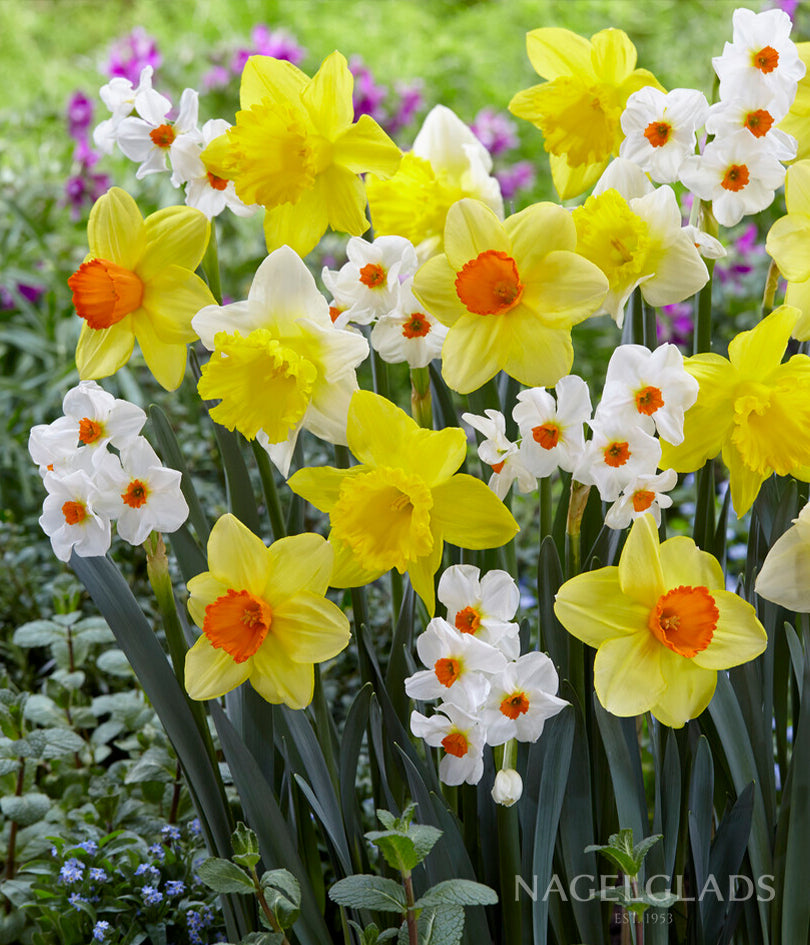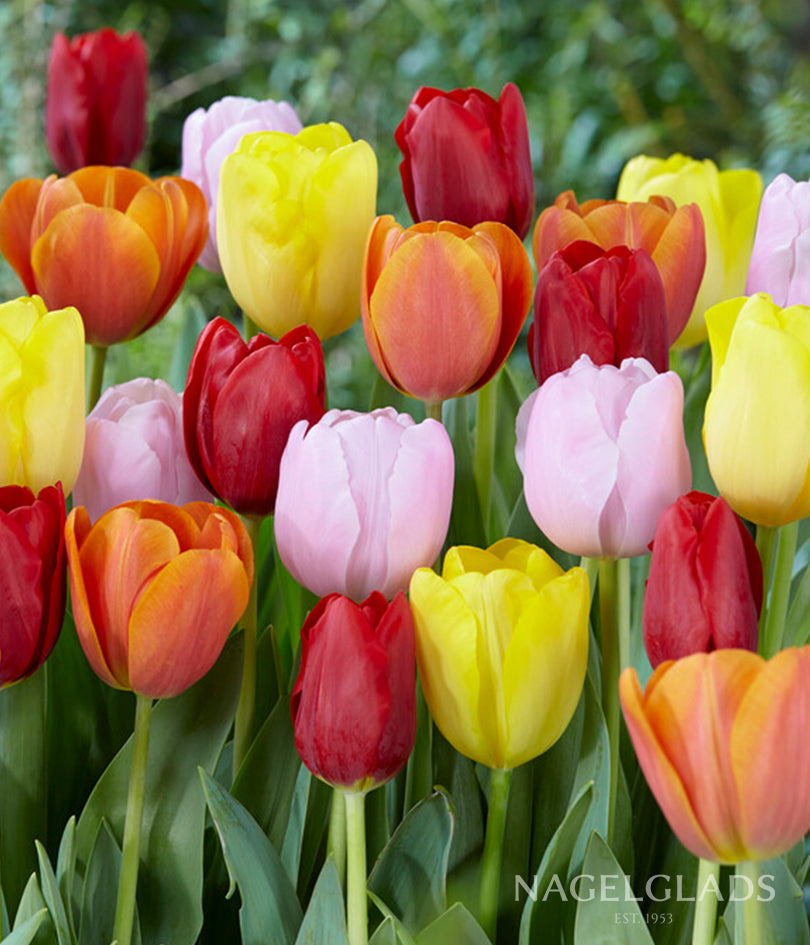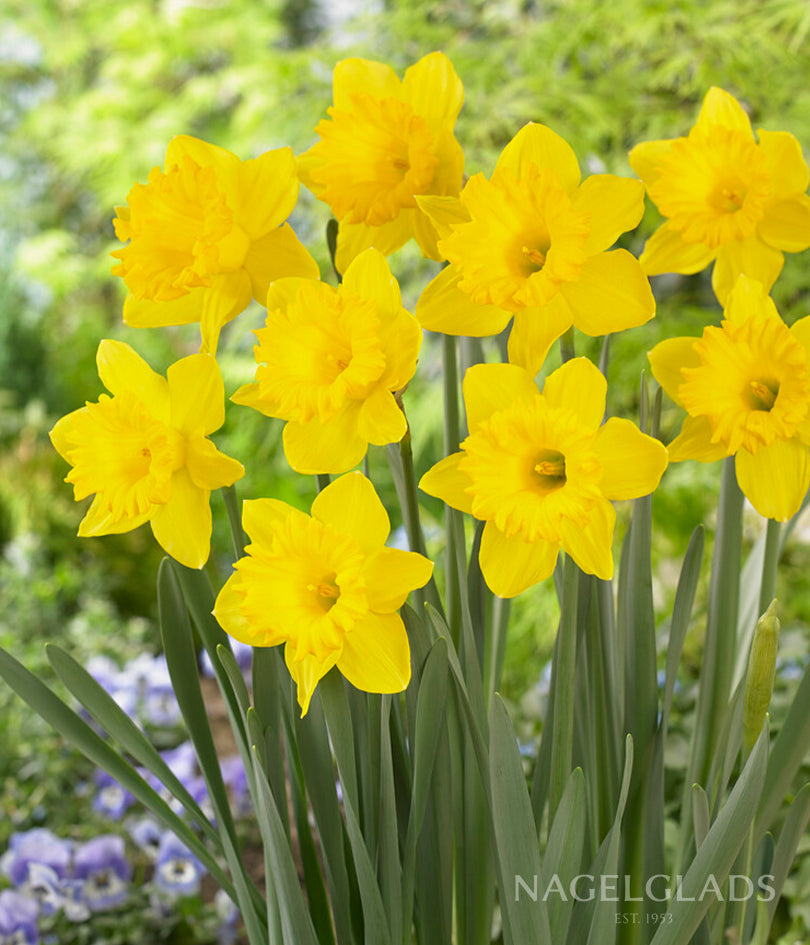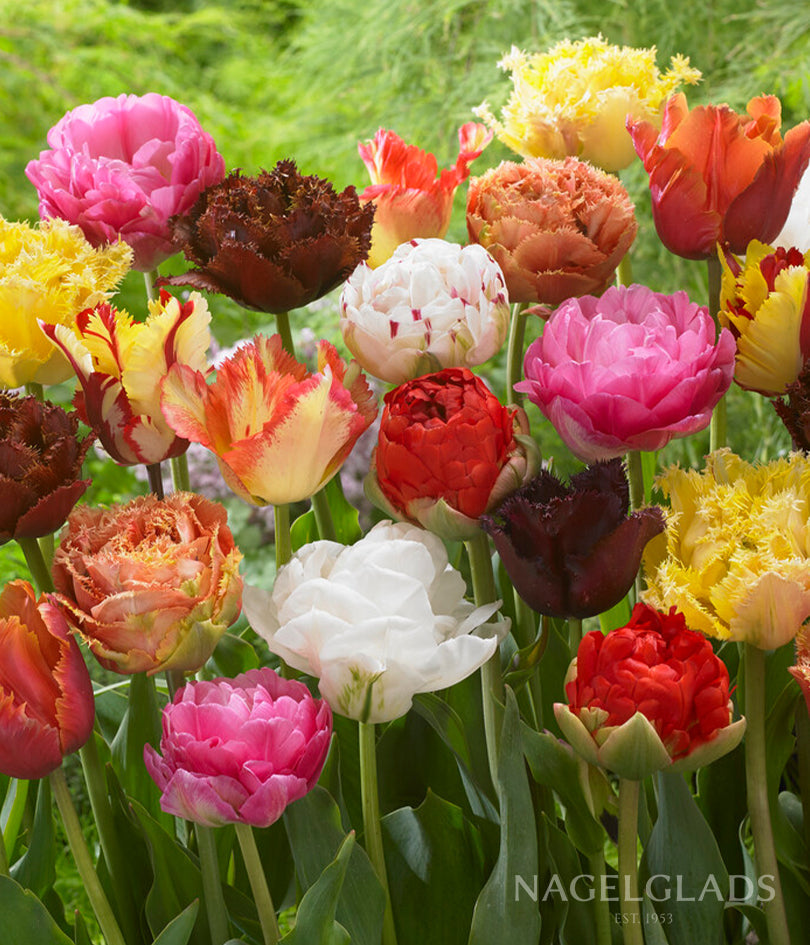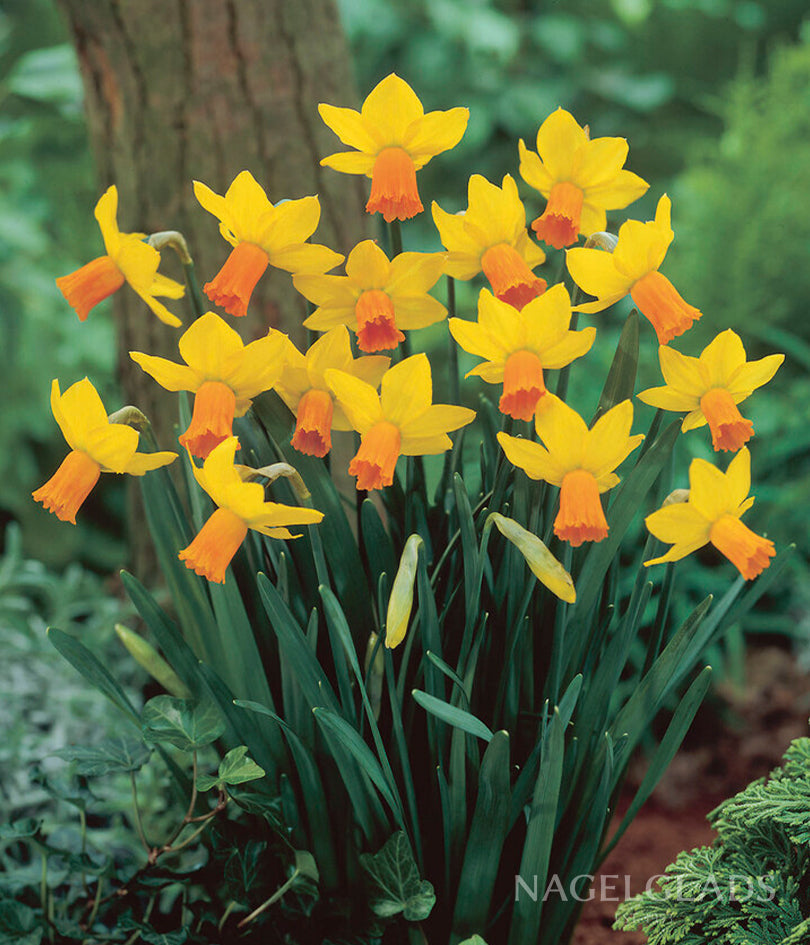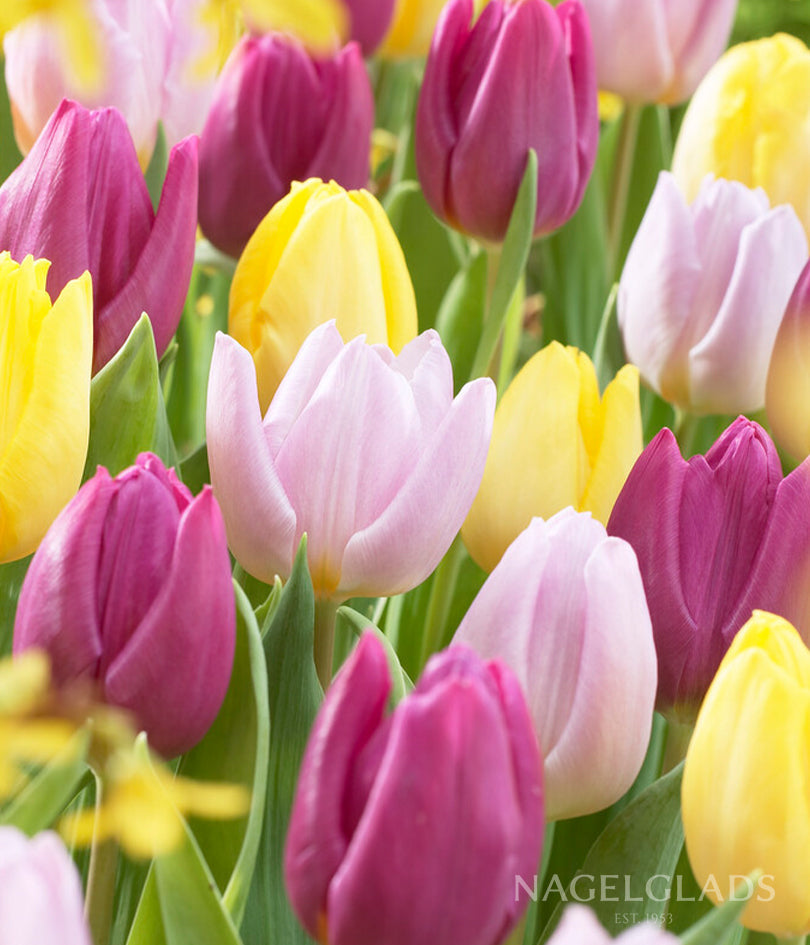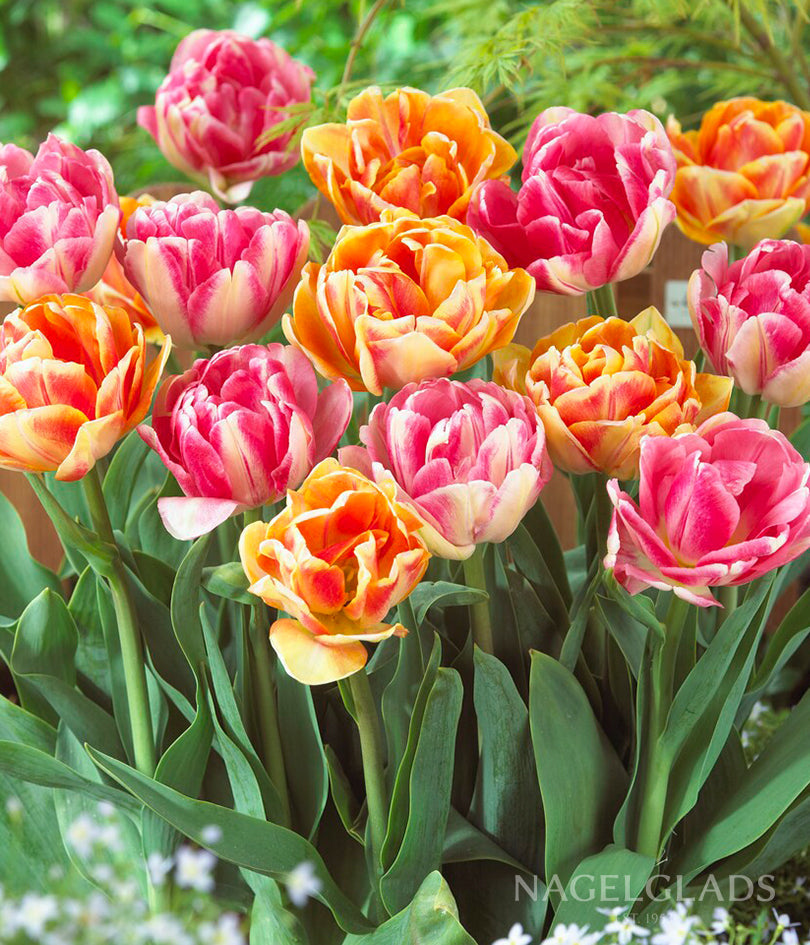Tulip & Daffodil Care & Tips
Soil and Preparation:
Proper soil preparation is essential for successful tulip and daffodil planting. Begin by selecting a well-drained location that receives full sunlight to partial shade. Loosen the soil to a depth of 12-15 inches to promote healthy root development. Incorporate organic matter, such as compost or well-rotted manure, to enrich the soil with nutrients and improve its structure. Ensure the soil pH is slightly acidic to neutral, ideally between 6.0 and 7.0, to create an optimal growing environment. Before planting, remove any weeds or debris to reduce competition for nutrients. Once the soil is prepared, plant tulip bulbs 6-8 inches deep and daffodil bulbs 3-6 inches deep, spacing them 4-6 inches apart. Water thoroughly after planting to settle the soil and encourage root establishment. Proper soil preparation will provide a strong foundation for vibrant blooms in the spring.
Planting:
Planting tulips and daffodils requires careful attention to depth, spacing, and timing to ensure a vibrant spring display. Start by selecting high-quality bulbs and a sunny to partially shaded location with well-drained soil. For tulips, plant the bulbs 6-8 inches deep, while daffodils should be planted 3-6 inches deep. Space the bulbs 4-6 inches apart to allow for adequate growth and airflow. Position the bulbs with the pointed end facing up. Planting should occur in the fall, ideally between late September and early November, when the soil temperature is below 60°F (15°C) to allow for proper root establishment before winter. After planting, water the area thoroughly to help settle the soil around the bulbs and promote rooting. Applying a 2-3 inch layer of mulch can help retain moisture and insulate the bulbs during the winter months. Following these steps will ensure a healthy, colorful bloom in the spring.
Watering:
Proper watering is crucial for the healthy growth of tulips and daffodils. After planting the bulbs in the fall, water them thoroughly to settle the soil and initiate the rooting process. Ensure that the water penetrates the soil to reach the bulbs, but avoid waterlogging, as this can cause the bulbs to rot
During the fall, if rainfall is insufficient, water the bulbs once a week, providing about 1 inch of water each time. Continue this routine until the ground freezes. Once the ground is frozen, additional watering is not necessary, as the bulbs will be dormant.
In the spring, as the bulbs begin to grow and the shoots emerge, resume regular watering. Tulips and daffodils require consistent moisture but should not be overwatered. Water them deeply once a week, ensuring the soil remains evenly moist but not soggy. It's best to water in the morning to allow excess moisture to evaporate during the day, reducing the risk of fungal diseases.
After the flowers have bloomed and the foliage starts to yellow, gradually reduce watering. This allows the bulbs to enter dormancy and prepare for the next growing season. Proper watering practices will support the growth and longevity of your tulips and daffodils, resulting in beautiful blooms each year.
Fertilization During Growth:
Fertilization is an important aspect of ensuring the healthy growth and vibrant blooms of tulips and daffodils. To start, mix a balanced, slow-release fertilizer into the soil when planting the bulbs in the fall. This initial feeding provides essential nutrients for root development during the winter months.
In the spring, as the shoots begin to emerge, apply a water-soluble, balanced fertilizer (such as a 10-10-10 or 5-10-10 formula) to support vigorous growth and flowering. Be sure to follow the manufacturer's instructions for the correct dilution and application rates. Apply the fertilizer when the foliage is dry to avoid burning the leaves, and water the plants thoroughly afterward to help the nutrients reach the root zone.
After the flowers have bloomed, continue to fertilize the plants until the foliage starts to yellow and die back. This post-bloom fertilization helps replenish the bulbs' nutrient stores, preparing them for the next growing season. Avoid high-nitrogen fertilizers during this period, as they can promote excessive leaf growth at the expense of bulb development.
Proper fertilization practices will enhance the overall health and flowering potential of your tulips and daffodils, ensuring a stunning display year after year.
Weed and Insect Control:
Effective weed and insect control are crucial for maintaining the health and beauty of tulips and daffodils. Here are some guidelines for managing these potential problems:
Weed Control
- Mulching: Apply a 2-3 inch layer of mulch around the plants. This helps suppress weed growth, retain soil moisture, and regulate soil temperature.
- Hand Weeding: Regularly check for and remove weeds by hand, especially around young shoots, to prevent competition for nutrients and water. Be careful not to disturb the bulbs or roots.
- Pre-emergent Herbicides: Use pre-emergent herbicides in the fall or early spring before weeds germinate. Select a product that is safe for use around bulbs and follow the manufacturer’s instructions.
Insect Control
- Monitoring: Regularly inspect plants for signs of insect damage, such as chewed leaves, holes, or distorted growth.
- Physical Barriers: Use physical barriers like row covers or netting to protect young plants from insect pests.
- Beneficial Insects: Encourage beneficial insects like ladybugs and lacewings, which prey on harmful pests. Plant companion flowers that attract these beneficial insects.
- Insecticidal Soap: For minor infestations, use insecticidal soap sprays to control aphids, mites, and other soft-bodied insects. Apply according to the label instructions, ensuring thorough coverage of the plants.
- Neem Oil: Neem oil is an effective organic option for controlling a wide range of insects. Spray it on affected plants, following the manufacturer’s guidelines.
By implementing these weed and insect control measures, you can protect your tulips and daffodils from common threats, ensuring they remain healthy and vibrant throughout their growing season.
Digging Corms (bulbs) **can stay the same**
If you live where the ground does not freeze in the winter, you may choose not to dig your corms; however, disease and crowding may reduce the amount and quality of your bloom. You should remove plant tops 6-8 weeks after bloom and remove them from the garden to prevent the spread of disease. It is suggested that you dig and divide your corms every couple of years, being sure to discard any damaged or diseased corms. If you live where the ground freezes, you will need to dig your corms each year, or if you choose not to dig, purchase new corms in the spring. Corms should be lifted in the fall before the onset of freezing weather. About 6-8 weeks after blooming, the corms may be harvested by loosening the soil with a spade or digging fork so that the plants can be pulled up by hand. The plant should be separated from the corm as close to the corm as possible, either by hand breaking or by cutting with pruning shears. You should remove the old plant tops from the field to prevent carryover of disease. The corms should be cleaned or rinsed off with running water, and then spread out to dry in shallow layers in trays or porous bags in an airy location that will not freeze for a period of 2 to 3 weeks. During this time a cork layer forms between the new corm and the old mother corm and roots. Break off and discard this old corm as soon as possible. Undue delay in cleaning results in greater difficulty in removal of the old corm.
Bulb Storage
Storing tulip and daffodil bulbs properly is essential to ensure they remain healthy and ready for planting in the next growing season. Here are the steps to store these bulbs effectively:
Cleaning and Preparing Bulbs
- Harvest Timing: Dig up the bulbs 6-8 weeks after blooming, once the foliage has yellowed and died back. This allows the bulbs to store energy for the next season.
- Digging Up: Carefully loosen the soil around the bulbs using a spade or digging fork. Lift the bulbs gently to avoid damage.
- Cleaning: Shake off excess soil and gently brush the bulbs clean. Do not wash them with water, as excess moisture can lead to rot. Remove any remaining plant tops and roots.
Drying
- Drying Process: Place the cleaned bulbs in a single layer on a tray, screen, or shallow container. Ensure they are in a dry, well-ventilated area out of direct sunlight. Allow the bulbs to dry for 1-2 weeks. This curing process helps to form a protective layer over the bulbs, preventing diseases and rot.
Storing
- Storage Containers: Once the bulbs are dry, store them in mesh bags, paper bags, or cardboard boxes with ventilation holes. Avoid using plastic bags as they can trap moisture, leading to rot.
- Storage Conditions: Store the bulbs in a cool, dark place with good air circulation. The ideal storage temperature is between 50-60°F (10-15°C). Ensure the storage area is dry to prevent mold and mildew.
- Avoid Freezing: Make sure the storage location does not freeze, as freezing temperatures can damage the bulbs.
Periodic Inspection
- Regular Checks: Periodically check the stored bulbs for signs of rot or disease. Remove any bulbs that show signs of decay to prevent them from affecting healthy bulbs.
By following these steps, you can ensure that your tulip and daffodil bulbs remain in good condition during their dormancy period and are ready for planting in the next growing season. Proper storage is key to preserving the health and vitality of the bulbs, ensuring a beautiful and bountiful display of flowers.


